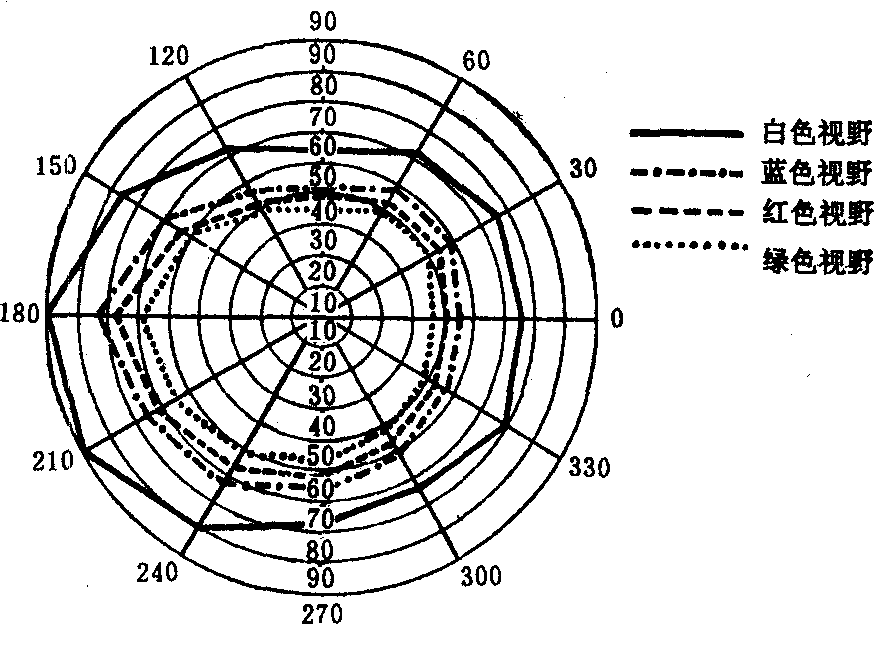视野shiye
即眼球向正前方注视时,所能看到的空间范围。视野也称周边视力,指黄斑中心凹以外的视力。视野可分为周边视野与中心视野两种。周边视野可用下述两种方法检查:(1)对比法:检查者与被检查者相对而坐,相距0.5~1米,检查右眼时被检查者遮左眼,检查者则遮右眼,用左眼注视被检查者右眼。检查者用手指于各方向作规律性移动,由外向里,用对比的方法了解被检查者有无视野缺损式缩窄。(2)周边视野计检查法:用弧形视野计,相距330毫米,遮盖另眼,被检眼注视中心圆视点,将3毫米白色视标由外向里慢慢移动,询问是否看到视标,或清晰度有无变化,根据弧的角度记录于周边视野纸上。正常人如用3毫米白色视标,距离为330毫米检查周边视野,范围平均上侧为55°,下侧为70°,鼻侧为60°,颞侧为90°。如用各种颜色视标检查,白视野最大,蓝、红、绿色视野依次缩小10°左右。中心视野,用平面视野计检查。检查注视点周围30°范围的视野,这部分相应的视网膜视敏度较高。检查距离为1米,遮盖另眼,被检眼注视中心固视点,选用1~3毫米白色视标,于各方向由周边向中心慢慢移动,记录视标消失或变为不清晰的位置于中心视野纸上。中心视野的固视点颞侧15.5°,水平线下1.5°处有一盲区,其大小为垂直径7.5°±2°,横径5.5°±2°,称生理盲点。这是眼底视乳头在视野计上的投影,因为视乳头上没有视细胞,所以这个区域内任何人都看不到视标。中心视野内除生理盲点外,任何其他盲区都是病理性的。完全看不到视标的盲区,叫绝对暗点;虽能看到视标,但不清晰,或不能明确辨认出颜色的盲区,叫相对暗点,视野检查对眼底病的诊断、鉴别诊断、视路疾病的诊断、病变的定位,以及对了解疾病的进展都有重要意义。

图499 正常单眼(左)视野范围
视野
眼底中央窝部位周围视网膜的视力范围。即眼球的视线保持平直方向且静止不动时,视线以外的事物可在视网膜上引起感觉的范围。正常人的视野范围呈一椭圆形,可分为三个区域:10°以内称为中心视野,10°-25°称为中间视野,25°以外称周边视野。一般鼻侧视野为60°左右,眉侧视野50°左右,面颊部视野为70°左右,外侧视野为90°左右(以白色视标检查)。检查视野的常规方法是用视野计,一般用白色视标在视野计上测量,其结果用视野图来表示。也有用正常视野对照测试的粗测方法,即以检查者的视野作为正常标准视野,来初步估计被检查者的视野是否正常。正常人在外侧部都有一生理盲点,若生理盲点发生变化或视野图上出现暗点,应稍加注意。盲点变化或暗点的出现常用来诊断早期青光眼。
视野shiye
指眼睛(单眼)向前平直注视时所能看到的空间范围,又称周边视野。它反映视网膜的普遍感光机能情况。一般用视野计测试。视野实际上是黄斑中央凹以外的视力,这部分视力虽不能看清物体,但对日常活动中探察周围环境是很重要的。视野与视网膜对应各点位置是左右、上下相反的,即颞侧视野反映鼻侧视网膜的功能,鼻侧视野反映颞侧视网膜的功能,上侧视野反映下部视网膜的功能,下侧视野反映上部视网膜的功能。视野的大小除决定于视网膜的结构及感光细胞在视网膜的分布外,还可由于视线被遮蔽而受影响。一般视野的上侧和内侧较小,这是受眼眶和鼻根限制的缘故。在颜色视野中,白色最大,黄蓝色较小,红色视野更小,绿色视野最小。这可能是由于感受各种颜色的视锥细胞在视网膜上分布的范围不同所致。
视野
用单眼或双眼固定地凝视正前方某一点不动时所能看见的空间范围。大小可通过视野计测定。
视野
又称“周围视力”。黄斑中心凹以外的视力。当眼球向正前方凝视不动时所见的空间范围,分为周边视野及中心视野,可分别用周边视野计和平面视野计检查,对诊断眼底病和视路病有重要价值。
视野
亦称“视界”或“视场”。指眼球固定注视前方一点时所能看到的空间范围。可分为单眼视野和双眼视野,双眼视野大于单眼视野。在同一光照条件下,用不同颜色测得的视野大小不同,白色视野最大,黄色和蓝色次之,红色再次之,而绿色视野最小。视野的大小除了与感光细胞在视网膜上的分布有关之外,还与面部的形态有关,如眼球凹陷者的视野较小等。视觉感受器的任何部分(如视网膜、视神经、视束和大脑皮层枕叶等)发生病变,均可导致视野异常。因此,临床上检查视野既可以了解视网膜的感光能力,又可了解眼科病变。视野大小还与年龄有关,一般至30岁时视野最大,以后随着年龄的增长而逐渐变小,60岁以后变小的速度更快,这与视网膜萎缩有关系。
视野
张家界电视台1997年3月开办的专栏节目。该栏目围绕党的方针、政策和市委、市政府中心工作进行宣传,兼顾社会生活方方面面。
视野
月刊。1991年创刊。原名 《金星》,1993年改为 《视野》, 由甘肃日报社主办。1997年改版,由兰州大学主办。16开本, 主要读者对象为大中专及高中学生, 兼顾有一定文化素养的其他各社会群体。
视野
眼球看到的空间范围。正常周边视野:上侧55°、下侧70°、鼻侧60°、颞侧90°。对各种颜色的视野也不同:白色最大,蓝、红、绿色视野依次递减10°左右,绿色视野最小。